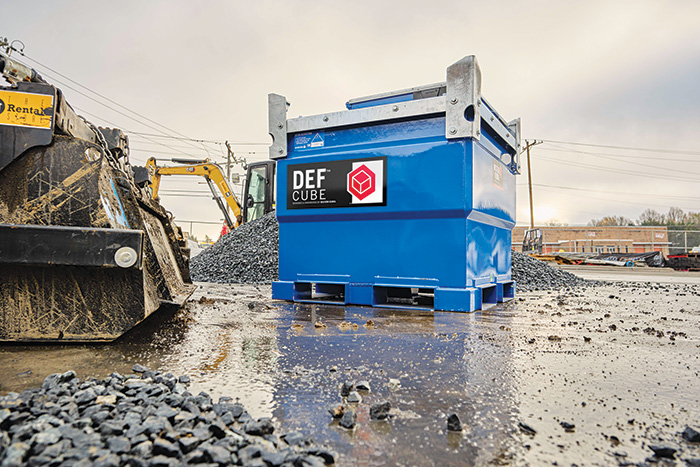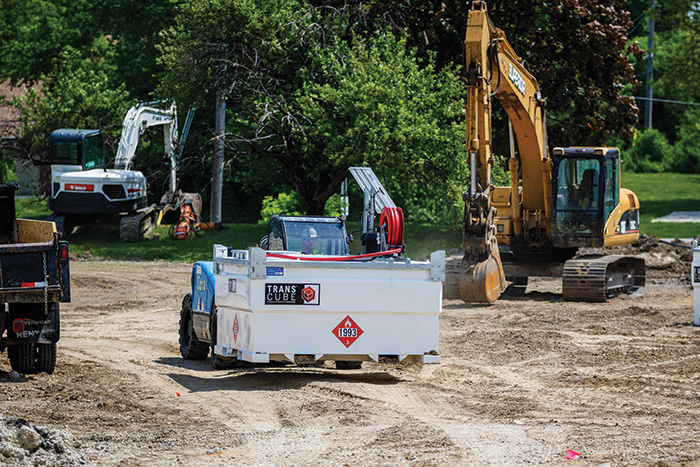By following a maintenance schedule throughout the seasons, you will help ensure an operation is ready for action through any type of weather.
By Jeff Lowe
Weather can have a significant impact on waste operations—especially when it comes to fuel. As a vital resource that keeps the site up and running, it is key to carry out regular inspections and checks to keep fuel in top condition.
Each season brings its own fuel tank maintenance challenges. Spring and summer offer an opportunity to make important checks and tests to ensure the tank is in good working order. During the autumn and winter months, regular inspections help ensure that no damage is caused to the tank or fuel by extreme weather.
These handy maintenance tips can keep fuel tanks risk-free and ready to refuel throughout the year.

Spring and Summer
Spring and summer can be a great opportunity to clean fuel storage tanks. Keeping tanks clean is vital to ensure they continue to work effectively. Depending on local regulations, operations may only be required to clean the tank once every several years. However, more and more companies are performing cleans on a regular basis. This helps avoid costly headaches that may result from debris or impurities in the tank.
The cleaning process involves using biocides that will kill any bacteria present in the tank, including diesel bug, and removing any sludge, impurities, or debris that may have settled at the bottom. If this debris is drawn through an engine or generator, it can cause significant damage, so it is important that it is removed.
As well as cleaning the tank itself, the area around the tank should be cleared of debris or vegetation every week—especially if using a stationary unit or leaving a transportable tank in one place for a long time. Plants can cause damage to the containment area through their root structure and vegetation can cause excess moisture, leading to corrosion. Keeping the area clean is a quick piece of routine maintenance that means drips, leaks, or spills can be identified straight away.
Double-walled fuel tanks simplify the cleaning and inspection process. Some manufacturers’ designs include a removable inner tank that makes cleaning and purging simple, and the inspection hatch helps users maintain and inspect the tank without having to fully take it apart. Proper care should always be taken when cleaning the tank, and the disposal of any fuel, residue, or chemicals should follow local regulations.
Check the containment area weekly for rainwater or fuel. If present, this will need to be removed and investigated. Rainwater left in the containment area can damage the tank. If any fuel is found, it is important to determine the cause. Was this from overfilling? Or is there an issue with the tank causing a leak? Identifying and fixing these at the earliest opportunity will help avoid any potential fines or further damage.
Removing water or product requires competence and the appropriate PPE. Any waste should be treated as hazardous and disposed of following local regulations.
The components within the tank, such as ball valves, vents, fittings, and pipelines, should be visually checked every week for signs of leaks or any damage that might stop them from working properly. Any damage should be fixed at the earliest opportunity.
Safety signage around the storage tank is extremely important. Display an easy-to-read “flammable” sign at the minimum, as well as any signs mandatory by law in the area. Signs warning against smoking and overfilling are also a good idea. Conduct a monthly check to ensure safety signs are not worn or damaged. If they are, make sure they are replaced immediately.
A fire extinguisher should be placed near the tank. Make a weekly check to ensure everything is in place and ready should the extinguisher be needed. Remember to make a calendar reminder to test and record the extinguisher pressure and function every six months.
This is a great opportunity to also check for bolt tightness and paint deterioration, which should also be done every six months.

Photos courtesy of Western Global.
Autumn and Winter
As the weather becomes colder and wetter, there are several potential implications for a fuel tank. As the weather fluctuates from freezing to milder temperatures, this puts an extra strain on tank materials. Be sure to check tank walls and all seams and joints to ensure there is no damage.
The fuel tank should ideally be located away from anything that could be a falling hazard, but after storms and strong winds, it is important to check the tank to ensure fallen trees, branches and any other debris that might have blown onto the tank have not caused any damage.
If the tank is running close to empty, water, sludge, and sediment can form at the bottom. When the weather is at freezing temperatures, this sediment can freeze and result in blockages and performance issues in heaters. It is best to keep the tank full to avoid pumping out any of this sludge.
Diesel fuel contains paraffin wax to increase lubrication and viscosity. As temperatures drop below the cloud point—when the fuel thickens and becomes cloudy—solid wax particles are formed. This can clog up machinery as the fuel is pumped and eventually render the fuel ineffective. Operations can use winter-grade fuel, add additives to the fuel or insulate the tank to help avoid this.
If using Diesel Exhaust Fluid (DEF), it is crucial to be especially careful in cold weather because DEF’s freezing point is typically around 12 degrees Fahrenheit—higher than most fuels. There are portable DEF tanks on the market with poly inner and steel outer tanks, which helps maintain the temperature of the fluid. Some manufacturers also offer an optional heater kit to keep DEF from freezing in cold climate applications.
With more frequent rain, snow, and ice—autumn and winter can increase the chance of water entering the fuel supply. If water does get into the fuel, it could freeze and cause serious problems. Be sure to check for contamination and follow a maintenance schedule throughout these seasons.
These simple service steps will help ensure an operation is ready for action through any type of weather. | WA
Jeff Lowe, Vice President of Product Marketing for Western Global, is a global designer and manufacturer of industry-leading tanks and equipment for fuel storage. Building on a legacy that spans more than six decades, Western Global offers a wide range of solutions for the safe transportation and storage of fuel. They have been serving the rental industry throughout all of these decades. Because every application is unique in its operational storage needs, Western Global continually engineers and re-engineers industry-specific solutions to meet the evolving fuel storage needs of their customers. Jeff can be reached at (743) 223-8266, e-mail [email protected], connect on LinkedIn at www.linkedin.com/company/westernglobal, or visit www.western-global.com.
